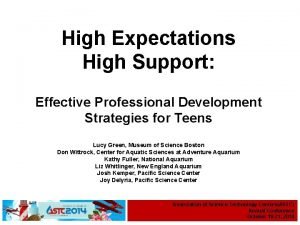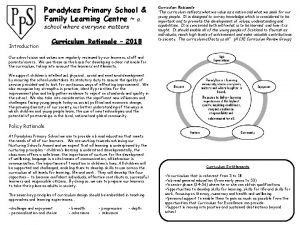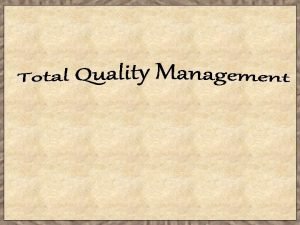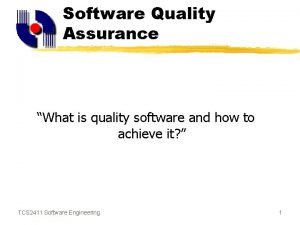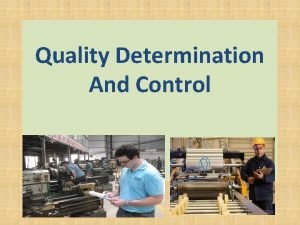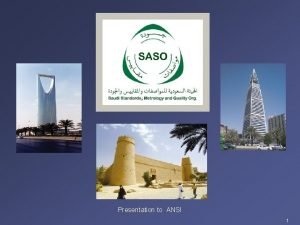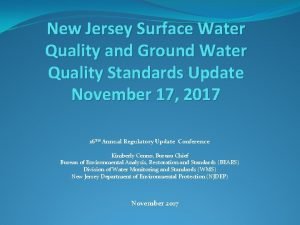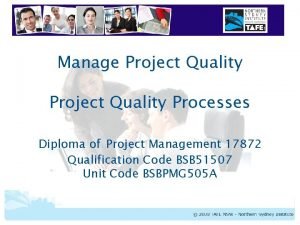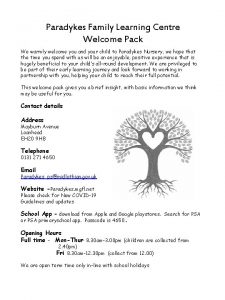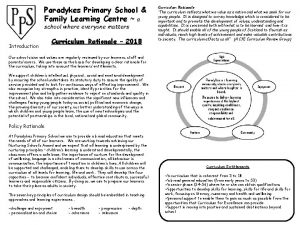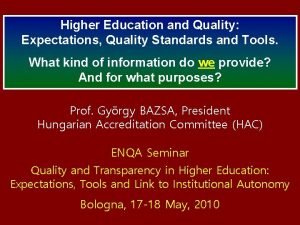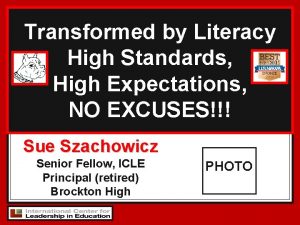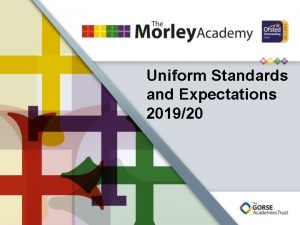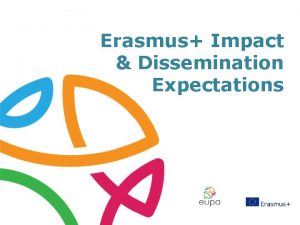Standards Quality Report 20152016 High Expectations Paradykes is










- Slides: 10

Standards & Quality Report 2015/2016 High Expectations Paradykes is a learning community where everybody matters and where laughter is heard. We aspire to deliver learning experiences of the highest quality, inspiring confidence, respect, resilience, responsibility and Respect achievement for all. Caring Enjoyment Improvement Plan August 2016 Community LASSWADE ASG VISION - To provide the highest quality of learning experiences for all children and young people in our community. We aim to achieve this through: Excellent learning and teaching; Working together in partnership; Ensuring a sense of belonging; Promoting achievement and attainment.

Standards and Quality Report ~ Session 2015/2016 SOME OF OUR ACHIEVEMENTS & SUCCESSES – Achieving Rights Respecting Level 2 Award; - Becoming a Fair. Aware School; - School Hockey Team coming 3 rd in Midlothian and being entered into National Finals; - Raising over £ 1 100 for charities, including UNICEF School in a Box and Children in Need; - making the most donations of any school to Midlothian Foodbank; - Nursery Hay bale planting; - continuing to develop local community links, including Loanhead Community Garden, IKEA and Loanhead Library; - Numerous individual achievements including, Calum Evans (P 7) in swimming, Kelly Wynne (P 7) being on the podium for her gymnastics skills, Ross Simpson (P 3) in karate, Ben Mapstone (P 7) with his Cornet playing, Kerr Notman (P 2) in Tae Kwon Do and a number of children being selected to play for various football teams; - Kirsty Murrin (Learning Assistant) completing a skydive; - the P 6 Learning Council, successfully introducing the language of learning from Nursery to P 7; - children moving from our “learning centre” back into class; - Primary 5 -7 children successfully completing Bikeability Training; - Nursery Bake Sale raising funds for their East Links Trip; - introducing French across the school; - efforts made by many children completing home learning tasks that evidence skills for learning, life and work; - Parent Council raising funds for ipads and other school activities; - use of Twitter to share learning and achievements; the introduction of Junior Award Scheme Scotland a small number of pupils already gaining their Bronze Awards. HOW GOOD ARE WE AT ENSURING THE BEST POSSIBLE OUTCOMES FOR ALL OF OUR LEARNERS? As a result of our approach to ensuring the wellbeing of our children and their families, we are improving outcomes for learners. Through the data gathered for successfully achieving our Rights Respecting Schools Level 2 Award, we know and can demonstrate that the overwhelming majority of our children feel safe, nurtured and respected. Relationships across the school community are positive and supportive, founded on a climate of mutual respect within a strong sense of community, shared values and high expectations for all. We consider each child as an individual with her/her own needs, risks and rights. Equity of opportunity and support remains a focus. We strive to ensure that all children are active participants in discussions and decisions which may affect their lives. All learners are included with the overwhelming majority being engaged and involved in the life of the school. Our average attendance continues to sit around the Authority target of 95. 5%. Exclusion rates are low. Curriculum Levels achieved at Primary 4 and 7 do not accurately reflect other attainment and assessment data collected. Primary 4 maths and Primary 7 writing in particular have very low results. Through professional discussion with staff, it is clear that moderation and building staff confidence in interpreting criteria for achieving a level requires a major focus next session. Further guidance from Education Scotland will be welcomed to support this work. Standardised testing results however show us that most learners are making good progress from their prior levels of attainment in reading and mathematics. We have raised attainment in both reading and numeracy at P 1, 4 & 7 with our P 7 reading score increasing to 1% below the Authority target of 90% (average score was 88% in 2013/14) and our P 7 mathematics score increasing to 4 points above the Authority target of a standardised score of 96 (average score was 97 in 2013/14). Overall, all of our learners are successful with many displaying confidence, exercising responsibility and contributing to the life of the school, wider community and as global citizens. High Expectations Paradykes is a learning community where everybody matters and where laughter is heard. We aspire to deliver learning experiences of the highest quality, inspiring confidence, respect, resilience, responsibility and achievement for all. Respect Caring Community Enjoyment

HOW GOOD IS THE QUALITY OF CARE AND EDUCATION WE OFFER? The quality of care and education on offer revolves around being a Level 2 Rights Respecting School which we were awarded in June 2016. The impact this had on the care and education we offer has been particularly identified by parents and reflected in the children’s knowledge and understanding of their rights. Staff are expected to have high expectations for all and strive to provide a nurturing, child centred learning environment. This session the school has continued to develop its Visible Learning journey. The Pupil Learning Council have identified ten learning dispositions which have been shared across the whole school. All of our learners have been familiarising themselves with learning dispositions and we are seeing more of them using this language in certain lessons within the classroom environment and some parents, particularly in the nursery, are commenting on their children’s use of the language at home. There is good evidence across the school that a range of learning environments and creative teaching approaches, particularly within interdisciplinary learning, are used to stimulate and engage most learners. Increasing numbers of children are beginning to use appropriate language when talking about their learning and next steps. Children are encouraged to lead their learning through discussion and in identifying key questions. Our curriculum has a clear vision and is grounded in our commitment to securing children’s rights and wellbeing. We have updated our rationale to ensure that it is unique to our learners and provides good opportunities for them to develop skills for learning and life, in particular. Further work is required to provide opportunities for developing skills for work. Greater focus has been given to planning to ensure that it is proportionate and manageable and clearly identifies what is to be learned. We now need to continue this work to ensure that the planning identifies what aspects are to be assessed. We have used a variety of assessment approaches to allow our learners to demonstrate their knowledge and understanding, skills, and attributes. Moderation processes, particularly in reading comprehension and writing are in place across the school and the evidence from this is valid and reliable. There is now a need to develop moderation processes across the Associated Schools Group, to support staff confidence in knowing when learners have achieved a level. We have made very good use of twitter to celebrate learners achievements in and out of school. We have launched the Junior Award Scheme in P 5 -7 to provide further opportunities to develop skills for learning, life and work and, to recognise personal achievements. HOW GOOD IS OUR LEADERSHIP AND APPROACH TO IMPROVEMENT? The Senior Leadership Team (SLT) continue to promote an ethos and culture where the overwhelming majority of staff feel valued and are empowered and trusted to be innovative and experimental with learning and teaching without the fear of being judged. Many staff at all levels take on leadership roles which have a direct focus on leading learning. Support Staff feel more included in the school improvement process. Closing the Gaps Meetings have been more focused in identifying areas for improvement. Identified areas for improvement have been supported by planned individual and collective career-long professional learning. In particular, Visible Learning input for support staff has allowed them to be more engaged in the learning process. Staff have been developing a clearer understanding of the social, economic and cultural context in which our learners and their families live. Moving forward with our aim to be nationally recognised as a Nurture school , it is fundamental that staff knowledge is further developed and a sustainable and agreed system is put in place to meet the needs of all children. Quality Indicator School Evaluation 1. 1 Self-evaluation for improvement Good 1. 2 Leadership of Learning Good 1. 3 Leadership of Change Good 2. 2 Curriculum Good 2. 3 Learning, teaching and assessment Good 3. 2 Raising attainment and achievement Good WHAT IS OUR CAPACITY FOR CONTINUOUS IMPROVEMENT? We continue to use a range of effective approaches to ensure that staff, parents/carers, our learners and other stakeholders are actively involved in our ongoing self evaluation process. Pupil participation in our regular circle meetings is a strong feature of our approach to self-evaluation and continuous improvement. Although we have accurate data about the quality of learning and teaching and the attainment and achievement of learners, this needs to be gathered more widely in order that we can monitor and track progress for all learners more accurately. Staff work effectively as a team. There is a strong ethos of sharing practice and of peer support. Opportunities need to be provided for staff to challenge the practice of their peers as appropriate. A programme for monitoring and evaluating learning and teaching and children’s achievements has been in place however this has not been as thorough as it could have been due to staff absence and the need for SLT members to teach more regularly. We have however, been able to show clear evidence of improvement based on actions taken as a result of self-evaluation.

Improvement Plan August 2016 High Expectations SCHOOL PRIORITIES : - Meeting the needs of all learners - Learning & Teaching - Developing our Curriculum Paradykes is a learning community where everybody matters and where laughter is heard. We aspire to deliver learning experiences of the highest quality, inspiring confidence, respect, resilience, responsibility and Respect achievement for all. Caring Enjoyment ASG PRIORITIES : - Health & Wellbeing - Moderation Across Learning in Literacy & Numeracy Community LASSWADE ASG VISION - To provide the highest quality of learning experiences for all children and young people in our community. We aim to achieve this through: Excellent learning and teaching; Working together in partnership; Ensuring a sense of belonging; Promoting achievement and attainment.

Paradykes Primary School Strategic Model 2016/2017 Scotland’s Vision for Education Scottish Government’s Purpose - To focus government and public services on creating a more successful country, with opportunities for all of Scotland to flourish, through increasing sustainable economic growth National Outcomes Our young people are successful learners, confident individuals, effective contributors and responsible citizens Our children have the best start in life and are ready to succeed We have improved the life chances for children, young people and families at risk We have tackled the significant inequalities in Scottish society Our public services are high quality, continually improving, efficient and responsive to local people’s needs National Vision for Education – Excellence through raising attainment: ensuring that every child achieves the highest standards in literacy and numeracy, set out within Curriculum for Excellence levels, and the right range of skills, qualifications and achievements to allow them to succeed; and Achieving equity: ensuring every child has the same opportunity to succeed, with a particular focus on closing the poverty-related attainment gap. National Improvement Framework Priorities Improvement in attainment, particularly in literacy and numeracy Closing the attainment gap between the most and least disadvantaged children Improvement in children and young people’s health and wellbeing Improvement in employability skills and sustained, positive school leaver destinations for all young people Midlothian’s Vision for Education Our vision is to provide the highest quality inclusive education and learning for all young people and families in Midlothian. To realise this vision this we will: Give all our children the best possible start in life, providing a nurturing and inclusive learning environment; Ensure that every young person has the opportunity to be a successful learner, confident individual, responsible citizen and an effective contributor; Work with our communities to promote high expectations which deliver the best educational outcomes for all learners; Celebrate diversity, reduce inequalities and remove barriers to learning. We aspire to deliver a world-class education system in Midlothian through a relentless focus on achieving better than our previous best. Strategic Outcomes – Excellence through raising attainment: Raise attainment in literacy, numeracy Close the Gap: Achieve equity by close the gap between the most and the least disadvantaged children GIRFEC: To improve children and young people’s health and wellbeing including the implementation of the named person Positive destinations: Continue to improve employability skills and sustained, positive destinations for all young people Lasswade Paradyke’s Vision for ASG Education Vision Our vision is to provide the highest quality of learning experiences for all children and young people in our community. We aim to achieve this through: Excellent learning and teaching; Working together in partnership; Ensuring a sense of belonging; Promoting achievement and attainment Paradykes is a learning community where everybody matters and where laughter is heard. We aspire to deliver learning experiences of the highest quality, inspiring confidence, respect, resilience, responsibility and achievement for all. Priority 1 – GIRFEC Priority 2 – Excellence Through Raising Attainment / Closing the Gaps - - Literacy & Numeracy Strategy - Visible Learning - Moderation - Outdoor Learning Nurturing School Attachment Aware Priority 3 – Positive Destinations - Developing skills for work Priority 4 – Health & Wellbeing (ASG) - Substance Misuse - Anti-Social Behaviour

PRIORITY 1 – GIRFEC - Key adults are allocated to support specific pupils identified with attachment difficulties Team around the Child approach is introduced for some pupils identified as having specific emotional needs Audit staff needs from Creating Confident Kids programme and then provide specific input as identified Begin the journey to achieve the National Nurturing Schools Award. PRIORITY 2 – EXCELLENCE THROUGH RAISING ATTAINMENT/CLOSING THE GAP - Continue to use research to improve achievement and attainment - focus on Visible Learning (Midlothian Council priority) - Implement action plan from our revised Strategy to Improve Outcomes in Literacy & Numeracy – see action plan - Develop a deeper language of learning across the school through further use of learning powers and in developing assessment capable learners - Undertake moderation work across ASG in relation to reading, writing, numeracy and mathematics (ASG action plan) - Make more effective use of outdoor learning to raise attainment and achievement PRIORITY 3 – POSITIVE DESTINATIONS - Update Curriculum Rationale to provide opportunities for all pupils to develop skills for work, including employability skills PRIORITY 4 – HEALTH & WELLBEING - Work across ASG to build a progressive programme - (3 -18) for Substance Misuse. - Work across ASG to build a progressive programme (3 -18) that addresses issues around anti-social behaviour linked to Mental, Emotional, Social and Physical Wellbeing

Priority 1 - GIRFEC Action – What will be done By Whom Milestones Indicators of Success 1 Staff to up skill themselves with the impacts of trauma and attachment. Staff will explore the impacts of trauma and attachment at their own level of knowledge – either looking at Underneath Distressed Behaviour or, Responding to Distressed Behaviour All staff August In-Set Days 2016 ü Staff will demonstrate a clearer understanding of the 2 Teams will be established “around” identified vulnerable children Teams will be established in order that key staff working with particular children are consistent in their approach and staff are supported through regular Team Around the Child Meetings. Led by HT, identified staff By December 2016 and then ongoing. üTeams are working in a consistent manner with 3 Content of Creating Confident Kids is audited against current staff knowledge and experience An audit will be carried out to “match” content of Creating Confident Kids Programme against school attachment and nurture work. Any gaps will be identified and then a plan of training will be formed by Ed. Psych Service and then provided as appropriate for staff. Ian Sargison, Ed. Psych Tim Wallace, HT By December 2016 üAppropriate training opportunities are identified for 4 Work towards achieving National Nurturing Schools Award by engaging in National Nurturing Schools Programme This is a 2 year programme where key staff will receive training and support in auditing current practice around nurturing principles, identify key actions for the school and also gaining knowledge in how to use the Boxall Profile to identify needs of children. Tim Wallace, HT Jennifer Sommerville, PT Beginning in September 2016 and achieving award by September 2018 üPerseverance, resilience and determination are impacts that trauma, attachment and brain development can have on their behaviour and, strategies for supporting these children. ü Strategies are being appropriately used across the school to support children. identified vulnerable children. üTeam Around the Child Meetings are reported to provide support for staff working with vulnerable children. üIdentified vulnerable children are receiving support in order for them to achieve at their own level. staff. üStaff have greater awareness of key content in Creating Confident Kids programme including, brain development, attachment and loss. modelled and recognised in adults and pupils üPupils are caught persevering, being resilient, handling difficult situations in a positive manner. üFailure is celebrated as a step towards understanding and children can confidently explain their steps to achieving.

Priority 2 – EXCELLENCE THROUGH RAISING ATTAINMENT/CLOSING THE GAP VISIBLE LEARNING In four months (Dec) during walkthroughs and observations it will be evident that all classes are routinely using learning intentions and success criteria. Pupils will fully understand what these mean and feedback to pupils will be based around these. Three walkthroughs or observations (data gathered, collated, shared with staff): Use of LI & SC Pupils’ understanding of these Feedback related to LI/SC Walkthroughs or observations (data gathered, collated, shared with staff): Use of LI & SC Pupils’ understanding of these Feedback related to LI/SC In eight months, (April) the ‘good learner’ video will show pupils talking about our agreed learner dispositions (rather than behavioural attributes). Staff, pupils and parents have a shared understanding of what a ‘good learner’ is. Through weekly reflections with children Teachers to monitor the responses of children The video will show children across the school using the learning dispositions to describe a good learner In ten months (June) when asked during class walkthroughs, pupils will be able to describe what they are learning and how they are doing with their learning in maths and numeracy All teachers must ensure they engage learners in discussion about their learning throughout lessons and reflection times. Record pupils responses in a range of ways. Most children will be confident in their response when asked specific questions about their learning and next steps in maths and numeracy.

Priority 3 – Positive Destinations Action – What will be done By Whom Milestones Indicators of Success 1 Staff will become more aware of the Career Education Standard 3 -18 Staff will explore during a CAT session, the entitlements and expectations of the Career Education 3 -18 All teaching staff, led by HT By end of November 2016 ü Staff are fully aware of the entitlements and 2 Key actions will be identified from the Career Standard and these will inform curriculum rationale. Staff will identify key actions from the standard and then encompass them within the curriculum rationale and curriculum planning. All teaching staff. Led by HT By end of January 2017 üPlanning of the curriculum provides opportunities for 3 Career Focus Week to be organised and held for whole school Staff will work to plan a career focus week, providing opportunities for children to develop skills for work and involving parents/carers and the wider school community All staff By end of May 2017 üChildren provide positive evaluation of Career Focus expectations within the Career Education Standard 318 children to develop skills for life and work Week üParents/carers and wider community provide support during career focus week üChildren are assessed as successfully developing skills for work at their appropriate lelvels.

Priority 4 CFE: HWB GIRFEC HGIOS 4 Task 1 Task 2 Task 3 Task 4 Task 5 Task 1 7 th October 16 Task 2 By Dec 16 Task 3 By Easter 17 Task 4 By Easter 17 Task 5 By Easter 17 To develop a consistent approach to tackling anti- social behaviour, including substance misuse, over the Lasswade ASG. (This follows a process of working with community professionals, identifying what ‘makes us unique’ in relation to GIRFEC. We identified substance misuse and anti social behaviour. ) The significant aspects of learning in health and wellbeing are: 1. Planning for choices and changes Learners are aware of their future choices and raise their expectations and aspirations of what will be possible. They develop the skills and attributes to secure positive destinations beyond school. 2. Physical activity, sport and health Learners establish a pattern of daily physical activity which is likely to lead to lifelong participation in sustained physical activity in adult life. They are able to access and take advantage of opportunities available locally to support their physical activity levels. Learners understand the links between diet and physical activity and the role they have in preventing obesity. 3. Substance misuse Learners understand the use and misuse of various substances. They understand the impact of risk-taking behaviour on their life choices. They make informed personal choices which promote a healthy lifestyle. 4. Relationships, sexual health and parenthood Learners develop their social skills and their understanding of how to maintain positive relationships with a variety of people. They are aware of how thoughts, feelings, attitudes, values and beliefs influence decisions about relationships and sexual health. They understand the complex role and responsibilities of being a parent or carer. Safe Protected from abuse, neglect or harm at home, at school and in the community. Healthy Having the highest attainable standards of physical and mental health, access to suitable healthcare, and support in learning to make healthy, safe choices. Achieving Being supported and guided in learning and in the development of skills, confidence and self-esteem, at home, in school and in the community. Nurtured Having a nurturing place to live in a family setting, with additional help if needed, or where possible, in a suitable care setting. Active Having opportunities to take part in activities such as play, recreation and sport, which contribute to healthy growth and development, at home, in school and in the community. Respected Having the opportunity, along with parents and carers, to be heard and involved in decisions that affect them. Responsible Having opportunities and encouragement to play active and responsible roles at home, in school and in the community, and where necessary, having appropriate guidance and supervision, and being involved in decisions that affect them. Included Having help to overcome social, educational, physical and economic inequalities, and being accepted as part of the community in which they live and learn. 1. 1: Self-evaluation for self-improvement 2. 1: Safeguarding and child protection 2. 2: Curriculum 2. 4: Personalised support 2. 6: Transitions 2. 7: Partnerships 3. 1: Improving wellbeing, equality and inclusion 3. 2: Raising attainment and achievement 3. 3: Increasing creativity and employability To arrange a CLPL session for Primary and Guidance staff, including input from Education Scotland Police Scotland, on 7 th October in Lasswade High School 1. 30 - 3. 30 To audit our current position To develop a curriculum overview on substance misuse from N-S 6 To agree annual inputs from Police and Fire services To agree annual assembly focuses P 1 -7 Book speakers to set the local and National context (May bring materials) Begin the audit of current position using an example of levels Collate audit to clarify current position Development group create a draft curriculum overview on substance misuse from N-S 6 Draft to be piloted in term 4 To agree annual inputs from Police and Fire services to begin in session 17/18 To agree annual assembly focuses P 1 -7 to begin in session 17/18
 High expectations high support
High expectations high support Paradykes primary school
Paradykes primary school Quality is meeting or exceeding customer expectations
Quality is meeting or exceeding customer expectations Set high expectations which inspire motivate and challenge
Set high expectations which inspire motivate and challenge Hard customer defined standards
Hard customer defined standards Iso 9001 software quality assurance
Iso 9001 software quality assurance Quality control standards
Quality control standards Pmbok quality assurance vs quality control
Pmbok quality assurance vs quality control Saudi standards, metrology and quality organization
Saudi standards, metrology and quality organization Njdep groundwater quality standards
Njdep groundwater quality standards What are quality standards in project management
What are quality standards in project management
